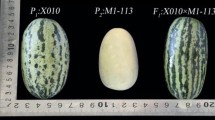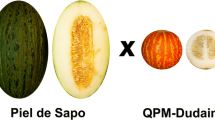Abstract
Monoecy is an important goal for melon breeding because of the agronomic advantages it provides to parental lines in that they do not require hand emasculation to develop monoecious F1 hybrids, the latter producing fruits of higher quality. Monoecious phenotype is conferred by the dominant allele of the andromonoecious (a) gene, whereas recessive homozygous plants are andromonoecious. A bulked segregant analysis (BSA) approach performed in a set of 38 double-haploid lines has allowed us to identify an AFLP marker linked to the a gene at 3.3 cM. Following cloning and sequencing of the AFLP fragment, specific PCR primers were designed and used in the amplification of a codominant SCAR marker. Using a backcrossed map** population of 530 plants, the SCAR marker could be mapped near the a locus (5.5 cM). Size difference between the two allelic SCAR fragments is 42 bp and might be due to a deletion/insertion. The SCAR marker is closest to the a gene identified to date, and can be useful in breeding programs, using marker-assisted selection procedures to screen for sexual types in melon.




Similar content being viewed by others
References
Ainsworth C (2000) Boys and girls come out to play: the molecular biology of dioecious plants. Ann Bot 86:211–221
Allard W (1956) Formulas and tables to facilitate the calculation of recombination values in heredity. Hilgardia 24:235–278
Charlesworth B (1991) The evolution of sex chromosomes. Science 251:1030–1033
Danin-Poleg Y, Reis N, Baudracco-Arnas S, Pitrat M, Staub JE, Oliver M, Arús P, de Vicente CM, Katzir N (2000) Simple sequence repeats in Cucumis map** and map merging. Genome 43:963–974
Danin-Poleg Y, Tadmor Y, Tzuri G, Reis N, Hirschberg J, Katzir N (2002) Construction of a genetic map of melon with molecular markers and horticultural traits, and localization of genes associated with ZYMV resistance. Euphytica 125:373–384
Deputy JC, Ming R, Ma H, Liu Z, Fitch MMM, Wang M, Manshardt R, Stiles JI (2002) Molecular markers for sex determination in papaya (Carica papaya L.). Theor Appl Genet 106:107–111
Filatov DA, Monéger F, Negrutiu I, Charlesworth D (2000) Low variability in a Y-linked plant gene and its implications for Y-chromosome evolution. Nature 404:388–390
Grant SR (1999) Genetics of gender dimorphism in higher plants. In: Geber MA, Dawson TE, Delph LF (eds) Gender and sexual dimorphism in flowering plants. Springer, Berlin Heidelberg New York, pp 247–274
Hormaza JI, Dollo L Polito VS (1994) Identification of a RAPD marker linked to sex determination in Pistacia vera using bulked segregant analysis. Theor Appl Genet 89:9–13
Kahana A, Silberstein L, Kessler N, Goldstein RS, Perl-Treves R (1999) Expression of ACC oxidase genes differs among sex genotypes and sex phases in cucumber. Plant Mol Biol 41:517–528
Kenigsbuch D, Cohen Y (1990) The inheritance of gynoecy in muskmelon. Genome 33:317–320
Kosambi DD (1944) The estimation of map distances from recombination values. Ann Eugen 12:172–175
Liu Z, Moore PH, Ma H, Ackerman CM, Ragiba M, Yu Q, Pearl HM, Kim MS, Charlton JW, Stiles JI, Zee FT, Paterson AH, Ming R (2004) A primitive Y chromosome in papaya marks incipient sex chromosome evolution. Nature 427:348–352
Lotfi M, Alan AR, Henning MJ, Jahn MM, Earle ED (2003) Production of haploid and doubled haploid plants of melon (Cucumis melo L.) for use in breeding for multiple virus resistance. Plant Cell Rep 21:1121–1128
Michelmore RW, Paran I, Kesseli V (1991) Identification of markers linked to disease-resistance genes by bulked segregant analysis: a rapid method to detect markers in specific genomic regions by using segregating populations. Proc Natl Acad Sci USA 88:9828–9832
Neuhausen SL (1992) Evaluation of restriction fragment length polymorphism in Cucumis melo. Theor Appl Genet 83:379–384
Périn C, Hagen LS, De Conto V, Katzir N, Danin-Poleg Y, Portnoy V, Baudracco-Arnas S, Chadoeuf J, Dogimont C, Pitrat M (2002a) A reference map of Cucumis melo based on two recombinant inbred line populations. Theor Appl Genet 104:1017–1034
Périn C, Hagen LS, Giovinazzo N, Besombes D, Dogimont C, Pitrat M (2002b) Genetic control of fruit shape acts prior to anthesis in melon (Cucumis melo L.) Mol Genet Genom 266:933–941
Polley A, Seigner E, Ganal MW (1997) Identification of sex in hop (Humulus lupulus) using molecular markers. Genome 40:357–361
Poole CF, Grimball PC (1939) Inheritance of new sex forms in Cucumis melo L. J Hered 30:21
Qu LJ, Foote TN, Roberts MA, Money TA, Aragón-Alcaide L, Snape JW, Moore G (1998) A simple PCR-bases method for scoring the ph1b deletion in wheat. Theor Appl Genet 96:371–375
Reamon-Bütter SM, Jung C (2000) AFLP-derived STS markers for the identification of sex in Asparagus officinalis L. Theor Appl Genet 100:432–438
Reamon-Bütter SM, Schondelmaier J, Jung C (1998) AFLP markers tightly linked to the sex locus in Asparagus officinalis L. Mol Breed 4:91–98
Robinson RW, Decker-Walters DS (1997) Cucurbits. CAB International, New York
Rosa JT (1928) The inheritance of flower types in Cucumis and Cytrullus. Hilgardia 3:233–250
Shattuck-Eidens DS, Bell RN, Neuhausen SL, Helentjaris T (1990) DNA sequence variation within maize and melon: observations from PCR amplification and direct sequencing. Genetics 126:207–217
Silberstein L, Kovalski I, Brotman Y, Périn C, Dogimont C, Pitrat M, Klingler J, Thompson G, Portnoy V, Katzir N, Perl-Treves R (2003) Linkage map of Cucumis melo including phenotypic traits and sequence-characterized genes. Genome 46:761–773
Staub JE, Danin-Poleg Y, Fazio G, Horejsi T, Reis N, Katzir N (2000) Comparative analysis of cultivated melon groups (Cucumis melo L.) using random amplified polymorphic DNA and simple sequence repeat markers. Euphytica 111:225–241
Stepansky A, Kovalski I, Perl-Treves R (1999) Intraspecific classification of melons (Cucumis melo L.) in view of their phenotypic and molecular variation. Plant Syst Evol 217:313–332
Trebitsh T, Staub JE, O’Neill S (1997) Identification of a 1-aminocyclopropane-1-carboxylic acid synthase gene linked to the Female (F) locus that enhances females sex expression in cucumber. Plant Physiol 113:987–995
Urasaki N, Tukumoto M, Tarota K, Ban Y, Kayano T, Tanaka H, Oku H, Chinen I, Terauchi R (2002) A male and hermaphrodite specific RAPD marker for papaya (Carica papaya L.). Theor Appl Genet 104:281–285
Vos P, Hogers R, Bleekers M, Reijans M, van der Lee T, Hornes M, Frijters A, Pot J, Peleman J, Kuiper M, Zabeau M (1995) AFLP: a new technique for DNA fingerprinting. Nucleic Acids Res 23:4407–4414
Westergaard M (1958) The mechanism of sex determination in dioecious flowering plants. Adv Genet 9:217–281
Whitaker TW, Davis DW (1962) Cucurbits: botany, cultivation and utilization. Interscience, New York
Author information
Authors and Affiliations
Corresponding author
Additional information
Communicated by I. Paran
Rights and permissions
About this article
Cite this article
Noguera, F., Capel, J., Alvarez, J. et al. Development and map** of a codominant SCAR marker linked to the andromonoecious gene of melon. Theor Appl Genet 110, 714–720 (2005). https://doi.org/10.1007/s00122-004-1897-0
Received:
Accepted:
Published:
Issue Date:
DOI: https://doi.org/10.1007/s00122-004-1897-0




